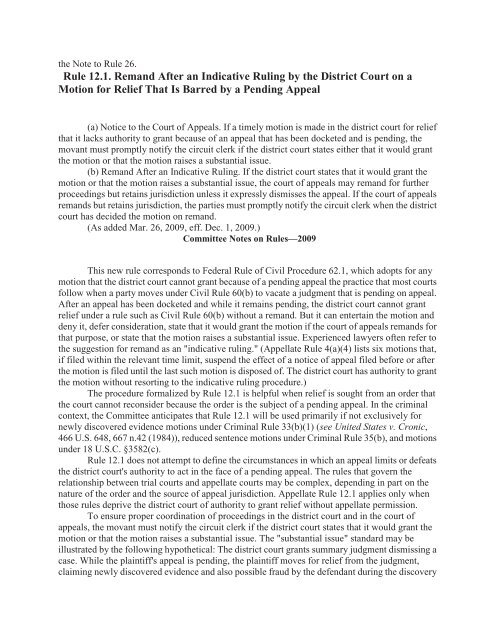Federal Rules of Appellate Procedure 2014-2015, 2014a
Federal Rules of Appellate Procedure 2014-2015, 2014a
Federal Rules of Appellate Procedure 2014-2015, 2014a
You also want an ePaper? Increase the reach of your titles
YUMPU automatically turns print PDFs into web optimized ePapers that Google loves.
the Note to Rule 26.<br />
Rule 12.1. Remand After an Indicative Ruling by the District Court on a<br />
Motion for Relief That Is Barred by a Pending Appeal<br />
(a) Notice to the Court <strong>of</strong> Appeals. If a timely motion is made in the district court for relief<br />
that it lacks authority to grant because <strong>of</strong> an appeal that has been docketed and is pending, the<br />
movant must promptly notify the circuit clerk if the district court states either that it would grant<br />
the motion or that the motion raises a substantial issue.<br />
(b) Remand After an Indicative Ruling. If the district court states that it would grant the<br />
motion or that the motion raises a substantial issue, the court <strong>of</strong> appeals may remand for further<br />
proceedings but retains jurisdiction unless it expressly dismisses the appeal. If the court <strong>of</strong> appeals<br />
remands but retains jurisdiction, the parties must promptly notify the circuit clerk when the district<br />
court has decided the motion on remand.<br />
(As added Mar. 26, 2009, eff. Dec. 1, 2009.)<br />
Committee Notes on <strong>Rules</strong>—2009<br />
This new rule corresponds to <strong>Federal</strong> Rule <strong>of</strong> Civil <strong>Procedure</strong> 62.1, which adopts for any<br />
motion that the district court cannot grant because <strong>of</strong> a pending appeal the practice that most courts<br />
follow when a party moves under Civil Rule 60(b) to vacate a judgment that is pending on appeal.<br />
After an appeal has been docketed and while it remains pending, the district court cannot grant<br />
relief under a rule such as Civil Rule 60(b) without a remand. But it can entertain the motion and<br />
deny it, defer consideration, state that it would grant the motion if the court <strong>of</strong> appeals remands for<br />
that purpose, or state that the motion raises a substantial issue. Experienced lawyers <strong>of</strong>ten refer to<br />
the suggestion for remand as an "indicative ruling." (<strong>Appellate</strong> Rule 4(a)(4) lists six motions that,<br />
if filed within the relevant time limit, suspend the effect <strong>of</strong> a notice <strong>of</strong> appeal filed before or after<br />
the motion is filed until the last such motion is disposed <strong>of</strong>. The district court has authority to grant<br />
the motion without resorting to the indicative ruling procedure.)<br />
The procedure formalized by Rule 12.1 is helpful when relief is sought from an order that<br />
the court cannot reconsider because the order is the subject <strong>of</strong> a pending appeal. In the criminal<br />
context, the Committee anticipates that Rule 12.1 will be used primarily if not exclusively for<br />
newly discovered evidence motions under Criminal Rule 33(b)(1) (see United States v. Cronic,<br />
466 U.S. 648, 667 n.42 (1984)), reduced sentence motions under Criminal Rule 35(b), and motions<br />
under 18 U.S.C. §3582(c).<br />
Rule 12.1 does not attempt to define the circumstances in which an appeal limits or defeats<br />
the district court's authority to act in the face <strong>of</strong> a pending appeal. The rules that govern the<br />
relationship between trial courts and appellate courts may be complex, depending in part on the<br />
nature <strong>of</strong> the order and the source <strong>of</strong> appeal jurisdiction. <strong>Appellate</strong> Rule 12.1 applies only when<br />
those rules deprive the district court <strong>of</strong> authority to grant relief without appellate permission.<br />
To ensure proper coordination <strong>of</strong> proceedings in the district court and in the court <strong>of</strong><br />
appeals, the movant must notify the circuit clerk if the district court states that it would grant the<br />
motion or that the motion raises a substantial issue. The "substantial issue" standard may be<br />
illustrated by the following hypothetical: The district court grants summary judgment dismissing a<br />
case. While the plaintiff's appeal is pending, the plaintiff moves for relief from the judgment,<br />
claiming newly discovered evidence and also possible fraud by the defendant during the discovery


















